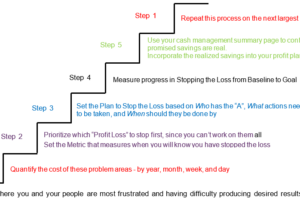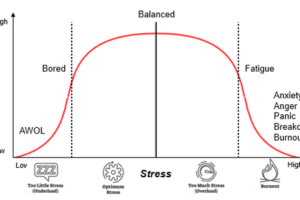Synopsis
The sooner you identify precisely where corrective action is needed, the sooner you will see improvements in your actual results. Your weekly management team return and report meetings are how this happens. If you aren’t meeting with your management team every week, you are making less money than you should.
One of the easiest ways to tell whether a business is in the higher or lower stages of business profitability is whether the owner of that business holds a weekly management team meeting or not? You can predict which of the five business stages a business is most likely in by sitting in on one of their weekly management meetings. This prediction in one meeting is made possible because the number one determiner of a company’s success is whether they have a management team in place that holds each other “accountable” for results as a company and by the team for sales, ops, and finance.
The purpose of any management team meeting is to use the meeting as a vehicle for identifying what actions need to take place to improve business results then hold each other accountable for realizing the agreed-upon actions that move the company forward. One of the primary reasons to hold a weekly management team meeting is to eliminate a common complaint among employees involving poor communication within the company. Too often, those working for you feel “out-of-the-loop.” They often don’t get information or the tools they need to do their jobs properly or have a forum to express their ideas for doing their jobs more effectively.
One of the negative consequences of not having management meetings involves the time-distracting habit of “catching” the boss when they are seen or being continually interrupted by employees throughout the day due to a lack of planned communication channels or set times to meet. Communication by interruption wastes valuable time and energy. At the same time, it increases frustration levels for all parties leading to lost productivity for both the employee and the owner resulting in an owner making less money because they don’t see the value in holding a weekly management team meeting.
An agenda-driven management meeting will ultimately reduce down or unproductive time by facilitating better communication. When confusion or misunderstanding exists, there is always frustration, decreased productivity, inefficiency, and ultimately profit losses. In contrast, increased communication through planned management actions will lead to less wasted cash and higher profits.
Don’t waste time in a poorly planned or weakly participated in management team meeting.
The goal of any weekly management team meeting is to use the meeting as a vehicle for identifying what actions need to take place to improve business results. Once needed actions are identified, it comes down to B-CPR Step 5 hold each other accountable for realizing the agreed-upon actions to improve business profits and cash flow.
At its core, your weekly management team meeting is intended to create focus through B-CPR Step 3 scorecard reporting according to the following:
- Metrics: Each metric has its “norm” or an objective set for each period. These objectives should be based on the Financial Plan and consistent with market conditions.
- Results: For each period, the results to date will be tracked and reported on the form. A comparison to the objective is made, and a hit or miss determination is made. Any contributing factors to the result, if essential, are listed to assist in the facilitation of discussion.
- Action: For each objective and result, the best action is identified to impact less than desired results enabling an enhancement or improvement to the result through implementing these strategies.
Management team meeting rules exist to ensure preparation for and participation in the meetings.
Meeting rules exist to help participants understand what to do or not to do in a specific situation. They establish the standards norm for guiding or mandating action or conduct. Below are the four rules for having money-making weekly management team meetings:
- Each participant must prepare in advance for their agenda item(s).
- To avoid distractions and interruptions, participants should make themselves “unavailable” during the meeting (cell phones turned off). Arrange for the phones to be answered by non-attendee(s) during the meeting. Except for urgent calls, plan on returning calls after the meeting. Take urgent calls outside of the meeting room.
- Participants must stay “on point” with the current agenda item and not stray from the topic at hand.
- An individual assigned an action item during the meeting must be prepared to discuss progress achieved on that item in the next meeting.
Five foundational steps to holding effective management team meetings:
- What do we want to do?
What is it exactly that we want to accomplish? This may be a simple statement or a more detailed plan, but an objective must be stated if we are expected to achieve it.
- When do we want it done?
What is the schedule? How long will it take to accomplish the objective? What is the ending or due date for completing the initiative? The time element must always be included to ensure progress and efficiency.
- How is it to be done?
What is the path we need to follow to reach our objective? As the HOW is defined, we will identify the necessary resources and functions to include in our action planning. As a part of resource requirements, we also determine HOW MUCH DOES IT COST? The answers to these questions will become our budget, forecast, or pricing model.
- By Whom?
Specifically, who is to be tasked/assigned to the effort and given the responsibility and necessary authority for attaining the objective? Who needs to be involved, when, and for how long? This is the assignment of accountability.
- Did we do it?
The final step in defining objectives is to establish criteria for measuring how closely the objective is being achieved for open-ended or long-term objectives. If the objective is finished, it’s a measure of how close we came to the goal set for the objective.
In confirming if we did what we set out to do, we also should learn from the experience, successful or not, and try to use it as a springboard for continuous improvement.
- Did we achieve, or are we making reasonable progress toward our objective?
- If the objective was achieved, did we do it on time? Did we do it efficiently within the planned resources/cost? If not, why not?
- If we failed to achieve or make reasonable progress toward our objective, what were the obstacles to our success, and why were we unable to overcome them?
- What did we learn, and how can we apply this knowledge in the future?
Five keys to successful management team meetings are:
- Participation is shown in follow-through on commitments = NEVER skip a meeting.
- Meeting dates are set well in advance and not juggled at the last minute.
- Standing agenda items and format of the agenda supports management priorities – setting goals and measuring the results in areas viewed as critical for the company’s success.
- Minimize straying from the topic at hand, so meetings are as informative and brief as possible.
- All participants demonstrate respect for each other’s time by coming prepared and by minimizing interruptions.
Confirming the quality of your profits through weekly KPI’s and monthly variance reports is best done through weekly management team meetings. Business CPR Step 3 is founded on the truism that you can’t control what you can’t manage, and you can’t manage what you can’t measure. Anything you want to improve starts by measuring it to confirm how you are doing relative to your established goals. Where are you doing better and worse than you planned to be?
The consistent action you need to take through what you learn in B-CPR Step 3 is critical to your business success because every profit dollar you earn results from past actions. The sooner you identify precisely where corrective action is needed, the sooner you will see improvements in your actual results. Your weekly management team return and report meetings are how this happens.
Is your management team helping you make more money?
If you are still unsure of the merits of a weekly management team meeting, click the link below to see how you can use financial metrics and ratios from your business to trigger more meaningful discussions on what’s working and where you are getting stuck in your business.
Within thirty-six hours of receipt of the multi-year P&L Statement and Balance Sheet, you will receive back by email your free sampling of financial metrics ratios you can start to use immediately in working with your management team to improve the results of your business.
Is your management team helping you make more money?
If you are still unsure of the merits of a weekly management team meeting, click the link below to see how you can use financial metrics and ratios from your business to trigger more meaningful discussions on what’s working and where you are getting stuck in your business.Within thirty-six hours of receipt of the multi-year P&L Statement and Balance Sheet, you will receive back by email your free sampling of financial metrics ratios you can start to use immediately in working with your management team to improve the results of your business.
FREE ASSESSMENT

